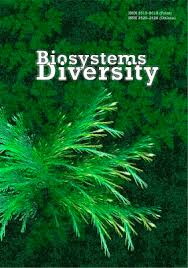The phenomenon of the shrinking size of bank vole (Myodes glareolus) in an anthropogenic environment (experience of 50 years of observations)
The phenomenon of the shrinking size of bank vole (Myodes glareolus) in an anthropogenic environment (experience of 50 years of observations)
Author(s): S.A. MyakushkoSubject(s): Environmental Geography, Post-War period (1950 - 1989), Transformation Period (1990 - 2010), Present Times (2010 - today)
Published by: Дніпропетровський національний університет імені Олеся Гончара
Keywords: size and mass parameters; shrinking; population dynamics; ecological balance;
Summary/Abstract: Fifty years of continuous monitoring of the bank vole population (Myodes glareolus Schreber, 1780) revealed the phenomenon of shrinking body size of individuals, manifesting in significant reduction in their regular size and mass parameters. Field observations were carried out in the Kaniv Nature Reserve (Cherkasy region, Ukraine) during the first half of summer every year. In the forest biotopes of the reserve, this species is dominant in the group of rodents. The research period covered various stages of the existence of the protected ecosystem. Its small area, location inadensely populated region of Ukraine and interaction with neighboring territories which are involved in economic activities have always caused anthropogenic pressure on the protected area. Its nature and intensity determined the changes in the protection regime and the loss of reserve status in 1951-1968. Later, the territory of the reserve experienced increasing technogenic pressure accompanied by radioactive contamination. In this work, to compare their characteristics, four complete cycles of the density dynamics of the bank vole population (from depression to depression) were selected, the duration of which was 4-5 years. The first three cycles correspond to qualitatively different periods in the existence of the ecosystem and the population of the studied species, and the last one corresponds to the relatively current situation. Over the recent 30 years, the size and mass parameters of individuals of bank voles have deсreased, - this phenomenon was called shrinking. The process was also observed to tend towards consistent increase in scale. Differentiated analysis shows that in different sex and functional groups of animals, the decrease in exterior parameters can reach 30.3%. Shrinking is especially notable in the group of adult females that are actively involved in reproduction (compared to the second cycle, considered as the control, the decrease in parameters among these is 33.2%). Juveniles of this sex lost 31.8% of their fatness. Besides, in the population of voles, the proportion of large-size individuals was significantly reduced. The group of animals that overwintered significantly reduced its representation, and its existing representatives had much smaller exterior parameters. The studies found that the shrinking process is stable over time, which does not allow it to be considered a random phenomenon or an artifact of research. This phenomenon has no correlation with the amount or availability of food. It occurs against the background of numerous changes in various aspects of population dynamics, which gives grounds to associate it with anthropogenic changes in the environment. Shrinking is believed to be realized through various mechanisms. Firstly, as a result of mortality, the largest individuals and reproducing females with the greatest energy needs disappear from the population, and secondly, the growth and weight gain of young animals is slower. As a result, decrease in the size and mass parameters of individuals reduces their specific energy needs and allows the population to bring their requirements in correspondance with the capability of the environment to support a certain number of resource consumers. An analogy was drawn with the Dehnel’s phenomenon, described for shrews of the Sorex genus, whose body size and weight decrease is an element of preparation for experiencing adverse winter conditions. Based on similar concepts, the shrinking of its elements can be considered as a specific population strategy to maintain the ecological balance.
Journal: Biosystems Diversity
- Issue Year: 29/2021
- Issue No: 3
- Page Range: 211-216
- Page Count: 6
- Language: English

